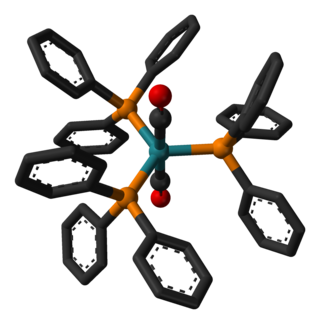Well-known inorganic and organometallic compounds and reagents that are named after individuals include:
- Adams' catalyst (proposed to be PtOx)
- Adamsite (NH(C6H4)2AsCl)
- Adkins catalyst (Cu2Cr2O5)
- Attenburrow's Oxide (MnO2)
- Arduengo carbene (class of compounds)
- Baeyer's reagent (KMnO4(aq))
- Benedict's reagent
- Bobbitt's salt (4-(Acetylamino)-2,2,6,6-tetramethyl-1-oxo-piperidinium tetrafluoroborate)
- Bertrand carbene (class of compounds)
- Brookhart's acid (H(OEt2)2BArF4)
- Buckminsterfullerene (C60)
- Burow's solution (Al(CH3CO2)3(aq))
- Calderon catalyst (WCl6/EtAlCl2/EtOH)
- Caro's acid (H2SO5)
- Chevreul's salt (Cu3(SO3)2 • 2 H2O)
- Chugaev's red salt ([Pt(C(NHMe)2N2H2](CNMe)2]Cl2)
- Chugaev's salt ([Pt(NH3)5Cl]Cl3)
- Cleve's triammine ([Pt(NH3)3Cl]Cl)
- Collman's reagent (Na2Fe(CO)4)
- Collins reagent (CrO3 / py / CH2Cl2)
- Condy's crystals (KMnO4)
- Corey–Chaykovsky reagent (O=S(CH2)Me2)
- Cornforth reagent ([pyH]2[Cr2O7])
- Crabtree's catalyst (Ir(COD)(py)(PCy3)+)
- Creutz–Taube complex ([(NH3)10Ru2(pyrazine)]5+)
- Etard's reagent (CrO2Cl2)
- Davy's reagent {(MeS)PS}2S2
- Deacon Catalyst (CuO/CuCl2)
- Dimroth's reagent (B(OAc)2)2O
- Durrant's Salt (K2[Co2(oxalate)4(OH)2]3H2O]
- Fehling's solution ([Cu(C4H4O6)2]4−)
- Fenton's reagent (Fe2+ / H2O2)
- Fetizon's reagent (Ag2CO3 / celite)
- Fischer carbene (class of compounds related to [(CO)5Cr=C(CH3)OCH3]
- Folin–Ciocalteu reagent (H3PMo12O40 / H3PW12O40)
- Furukawa's cyclopropanation reagent (ZnEt2 / CH2I2)
- Frémy's salt (Na2NO(SO3)2)
- Gilman reagents (R2CuLi, class of compounds)
- Glauber's salt (Na2SO4·10H2O)
- Gmelin's salt (K3Fe(CN)6)
- Gingras reagent (Ph3SnF2.NnBu4)
- Grignard reagents (RMgX, class of compounds)
- Grubbs catalyst (RuCl2(PCy3)2(CHPh))
- Hauser base (R2NMgBr)
- Hoveyda–Grubbs catalyst (RuCl2(PCy3)(CH(C6H4)OiPr))
- Jacobsen's catalyst (derivative of Mn(salen)Cl)
- Jones reagent (CrO3 / H2SO4(aq) / Me2CO)
- Jordan's cation ((Cp)2Zr(Me)(THF)+)
- Kagan's reagent (SmI2)
- Karstedt's catalyst (Pt2{(CH2=CH2Si(Me)2)2O}3)
- Kauffmann's reagent ({O=M(THF)2Cl(mu-CH2)}2 M = Mo, W)
- Keinan reagent (SiH2I2)
- Kläui ligand {(C5H5)Co[(CH3O)2PO]3}−
- Knölker complex (Fe(CO)2H(hydroxycyclopentadienyl))
- Knowles' catalyst ([Rh-DIPAMP-COD]BF4)
- Kobayashi's anion (B[3,5-(CF3)2C6H3]4−)
- Koser's reagent (PhI(OTs)OH)
- Lawesson's reagent ([CH3OC6H4PS2]2)
- Lazier catalyst (Cu2Cr2O5)
- Lemieux-Johnson reagent (NaIO4 / OsO4)
- Lewisite (ClCH=CHAsCl2)
- Ley-Griffith reagent (RuO4N(C3H7)4)
- Lindlar catalyst (Pd / CaCO3 / PbO)
- Lombardo reagent (CH2Br2 / TiCl4 / Zn)
- Lucas' reagent (ZnCl2 / HCl(aq))
- Luche reagent (NaBH4 / CeCl3)
- Magnus' green salt (Pt2(NH3)4Cl4)
- Magnus' pink salt (polymorph of Magnus' green salt)
- Marignac's salt (K2Ta2O3F6)
- Meerwein's reagent [(CH3CH2)3O]BF4
- Meisenheimer complex
- Millon's Base (Hg2N)OH(H2O)x
- Millon's reagent (Hg/HNO3(aq))
- Mohr's salt (NH4)2Fe(SO4)2·6H2O
- Negishi reagent (Cp2ZrBu2)
- Nessler's reagent (K2HgI4)
- Normant reagents (RMgX + CuX)
- Nugent's reagent (TiCp2Cl)
- Nysted reagent (ZnCH2(ZnBr)2.THF)
- Pearlman's catalyst (proposed to be Pd(OH)2/C)
- Péligot's salt (KCrO3Cl)
- Periana catalyst (Pt(2,2'-Bipyrimidine)Cl2)
- Petasis reagent (Cp2TiMe2)
- Peyrone's salt (cis-PtCl2(NH3)2)
- Piers' borane (HB(C6F5)2)
- Piers' catalyst (RuCl2(PCy3)CHPCy3.BF4)
- Prevost's reagent (Ag(OBz) / I2)
- Raney nickel (hydrogen dissolved in high surface area nickel)
- Reinecke's salt (NH4[Cr(NCS)4(NH3)2].H2O)
- Reiset's second chloride (trans-PtCl2(NH3)2, his first salt is Peyrone's salt)
- Rice's Bromine Solution (Br2 / NaBr(aq))
- Rieke metals (class of materials)
- Rochelle salt (KNaC4H4O6·4H2O)
- Roussin's black salt (KFe4S3(NO)7)
- Roussin's red salt (K2Fe2S2(NO)4)
- Scheele's green (CuHAsO3)
- Schlosser's base (nBuLi/KOtBu)
- Schrock carbene (class of compounds related to [((CH3)3CCH2)3Ta=CHC(CH3)3]
- Schrock catalyst
- Schrock-Osborn catalyst (CODRh(PPh3)2+)
- Schultze reagent (KClO3 / HNO3)
- Schweinfurter Green (Cu(OAc)2·3Cu(AsO2)2)
- Schwartz's reagent (Cp2Zr(H)Cl)
- Schweizer's reagent ([Cu(NH3)4(H2O)2](OH)2)
- Schwessinger base (P(NP(NMe2)3)3(NtBu))
- Scott-Wilson Reagent (Hg(CN)2/AgNO3/KOH)
- Seignette's salt (KNaC4H4O6·4H2O)
- Seyferth reagent (PhHgCCl3)
- Shilov catalyst (PtCl2 / H2PtCl6)
- Sharpless reagent (Ti(OiPr)4 / diethyl tartrate / tBuOOH)
- Shvo catalyst ((C5Ph4O)2HRu2H(CO)4)
- Simmons–Smith reagent (ICH2ZnI)
- Sonnenschein's Reagent (H3PMo12O40)
- Speier's catalyst (H2PtCl6)
- Spirit of Mindererus (NH4CH3CO2(aq))
- Stiles' reagent (Mg(OCO2Me)2)
- Stryker's reagent (Cu6H6(PPh3)6)
- Swart's reagent (SbF3)
- Tebbe's reagent (Cp2TiCl(CH2)AlMe2)
- Tollens' reagent ([Ag(NH3)2]+)
- Trinder reagent (10% FeCl3(aq))
- Turnbull's blue (Fe7(CN)18⋅14H2O)
- Udenfriend reagent
- Ugi's amine (Fe(Cp)(C5H4CH(Me)(NMe2))
- Vauquelin's Salt (Pd analogue of Magnus' green salt, Pd2(NH3)4Cl4)
- Vaska's complex (trans-IrCl(CO)[PPh3]2)
- Vedejs' reagent (Mo(O)(O2)2(py)(OP(NMe2)3))
- Wagner's Reagent (I2 / KI / H2O)
- Wanzlick carbene (class of compounds)
- Well's salt (CsAuCl3)
- White catalyst ((PhS(O)CH2CH2S(O)Ph).Pd(OAc)2)
- Wij's Solution (ICl / acetic acid)
- Wilkinson's catalyst (RhCl(PPh3)3)
- Wolffram's Red Salt [Pt(C2H5NH2)4][Pt(C2H5NH2)4Cl2]Cl4·4H2O
- Woollins' reagent ((PhP(Se)Se)2)
- Zeise's salt (K[PtCl3(C2H4)]·H2O)
- Zerewitinoff Reagent (MeMgI / nBu2O)
- Zhan catalyst (RuCl2(PCy3)(CH(2-SO2NMe2-C6H3)OiPr))
- Ziegler–Natta catalyst
- ZoBell's solution (KCl/K4[Fe(CN)6]/K3[Fe(CN)6])











